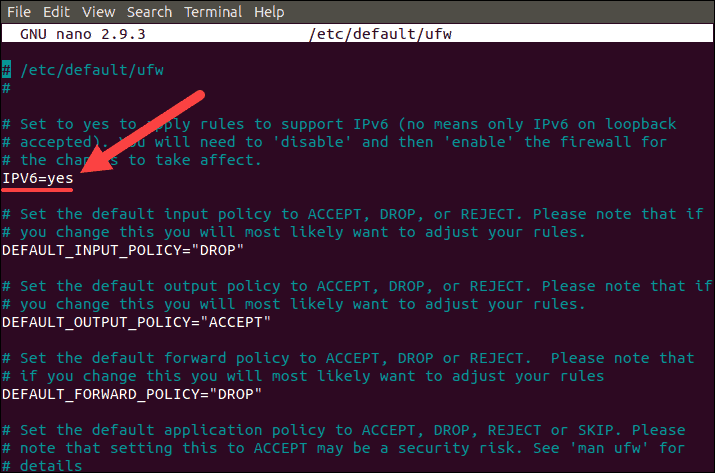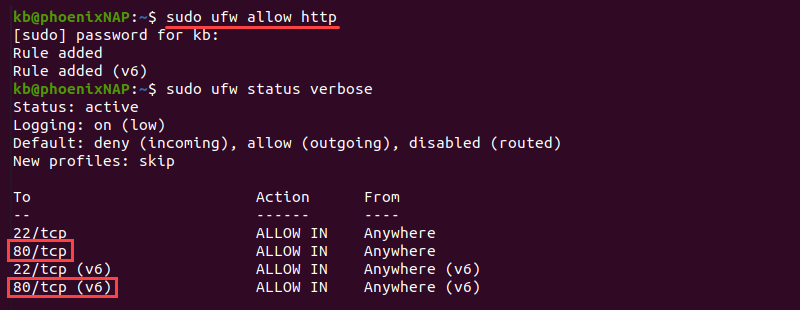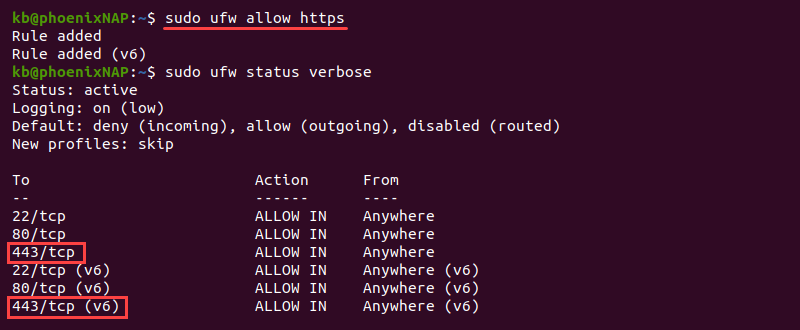Introduction
The first step in securing your system is configuring a firewall. To set up and manage firewalls, Linux has designed various utilities flexible utilities, such as iptables.
However, users who are new to network security may find iptables a bit intimidating. That’s why we recommend starting with UFW.
UFW (Uncomplicated Firewall) is a user-friendly interface implemented on top of iptables. It provides a simple way to configure a firewall.
In this tutorial, you will learn how to set up firewall protection on an Ubuntu system with UFW.

Prerequisites
- A system running Ubuntu 18.04, 20.04 or 22.04.
- A user account with sudo privileges.
- Access to a command line/terminal window (Ctrl+Alt+T).
Setting up UFW
The UFW firewall setup includes instructions on how to install and configure default firewall settings. Follow the steps below to see how to install and use the tool.
Install UFW on Ubuntu
UFW comes pre-installed on Ubuntu 20.04 and Ubuntu 22.04. In case you do not have UFW, run the following command to install it:
sudo apt install ufwWait for the installation to complete.
Configure UFW to Support IPv6
If the system uses both IPv4 and IPv6, modify the UFW configuration file to support both protocols.
1. Open the default settings file using nano or any other text editor:
sudo nano /etc/default/ufw
2. If the IPv6 value is set as no, change the value to yes to enable IPv6 use.
3. Save and close the file.
Set Up Default UFW Policy
The default UFW configuration is set to allow all outgoing connections and deny all incoming connections. The two rules are typical for personal computers, which do not need to respond to incoming requests.
If you changed the default settings and want to return to the default behavior, run the following command to deny incoming connections:
sudo ufw default deny incomingAllow outgoing connections by running:
sudo ufw default allow outgoing
The two commands return the status of UFW to the default settings.
Allow SSH Connections
If you plan to connect to your server from remote locations, you need to set up UFW to allow incoming SSH connections.
Configure UFW to allow SSH connections with the command:
sudo ufw allow ssh
The command adds a rule for IPv4 (and IPv6 if enabled) to allow incoming and outgoing traffic from SSH connections.
Enable UFW
After configuring the settings, disable and enable the UFW firewall for the changes to take effect. Disable UFW by entering:
sudo ufw disableEnable the firewall again with the following command:
sudo ufw enable
The commands output the firewall status after each action. The firewall is now active and enabled on startup.
Check UFW Status
To check UFW status and show detailed information, run the following command:
sudo ufw status verbose
The output shows the status, default settings, and open ports.
Working with UFW Rules
UFW is a rule-based firewall. The rules define the extent of communication the server has with other machines.
Specify which connections are allowed and which are denied to control firewall settings further.
Allow Incoming Connections on Other Ports
Depending on the server's purpose, allow specific incoming connections for additional firewall control. Create UWF rules to add the connections to the firewall configuration.
Below is a list of commands for common setups.
1. Set your server to listen to HTTP by running:
sudo ufw allow httpAlternatively, use port number 80 for HTTP connections:
sudo ufw allow 80The rule is visible in the UFW status:
sudo ufw status verbose
The command allows traffic on HTTP port 80 and adds rules for IPv4 and IPv6.
2. To enable HTTPS connections, use the following command:
sudo ufw allow httpsAlternatively, use port number 443 for HTTPS connections:
sudo ufw allow 443Check the UFW status to confirm the new rule is visible:
sudo ufw status verbose
The enabled HTTPS connections on port 443 are visible for IPv4 and IPv6.
3. To set a rule that allows access to all ports from a specific IP address, run:
sudo ufw allow from <IP address>Use this method to set a rule to allow all traffic from a remote server to a local machine or from a remote machine to a local server.
4. To allow access from a particular machine to a specific port, run the command:
sudo ufw allow from <IP address> to any port <port number>The rule limits access to the specified port only.
5. To allow access to a range of ports, specify the range values and the protocol type (TCP or UDP). For instance, the following command allows connections from ports 2000 to 2004 for TCP:
sudo ufw allow 2000:2004/tcpChange the protocol to allow connections from ports 2000 to 2004 for UDP with the following:
sudo ufw allow 2000:2004/udpNote: TCP (Transmission Control Protocol) is a connection-oriented protocol that guarantees that all the data transmitted is in order. UDP (User Datagram Protocol) is a connection-less oriented protocol that transfers data faster but is less reliable.
Deny Incoming Connections on Other Ports
To create a deny rule to forbid connection from a specific IP address, run the command:
sudo ufw deny from <IP address>Alternatively, deny access to particular ports by typing:
sudo ufw deny from <IP address> to any port <number>Use the two commands to block traffic from suspicious IP addresses or secure a specific port.
Deleting UFW Rules
The UFW firewall is flexible and allows deleting rules. There are two ways to remove a rule.
1. Display a list of all the rules and find the assigned number of the rule. First, display the rules as a numbered list:
sudo ufw status numbered
The output lists the rules added so far. Each rule has a number according to the order in which it was set.
Delete a rule using the following syntax with the appropriate rule number:
sudo ufw delete <rule number>The command removes the rule from the list, and the numbers change accordingly.
2. An alternative way to delete a rule is to specify it word for word:
sudo ufw delete <rule>For example, to remove a rule that allows connection to port 2000, use the command:
sudo ufw delete allow 2000The command removes the rule from the list.
Application Profiles
Each package installed with the apt command has an application profile in the /etc/ufw/applications.d directory. The profile provides information about the software and its UFW settings.
To see the list of all application profiles, use the command:
sudo ufw app list
See more information about a specific package (along with open ports) by running the following command:
sudo ufw app info '<package name>'For example, to show the application profile for Apache, run:
sudo ufw app info 'Apache Full'
The output shows the profile information, a short application description, and the ports the app uses.
Note: Learn how to use GUFW, a graphical user interface for UFW, to configure a firewall.
Conclusion
By following the instructions in our guide, you should know how to use UFW to set up a firewall. Ensuring stable firewall protection is the first step to protecting your server.
Additionally, learn more about server protection by checking out our list of 21 Server Security Tips.